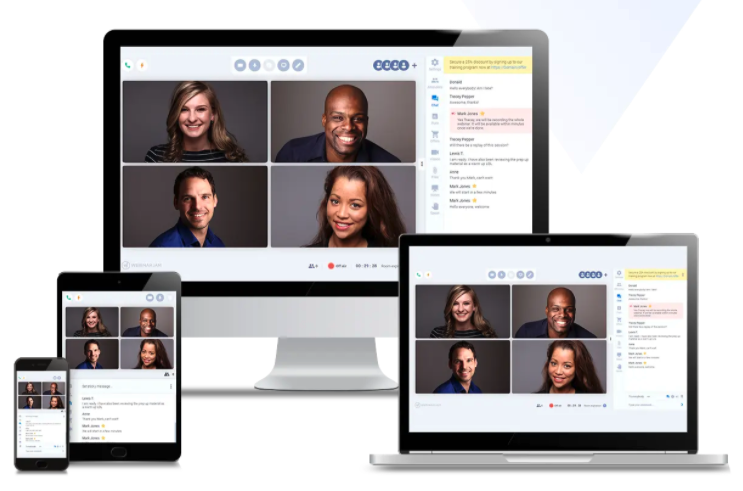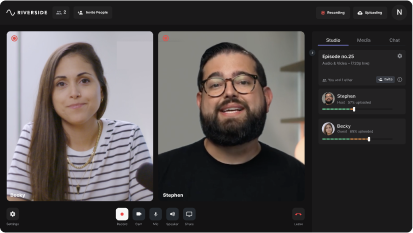Last Updated
May 26, 2023
6 Best Webinar Platforms for Companies (2023 Overview)
-(1).png)
Webinars have skyrocketed in popularity in the last few years—and it’s easy to see why. They’re a fantastic marketing tool that lets you connect with your target audience, demonstrate your expertise in your niche, and generate leads as a result.
And the secret to maximizing your webinar marketing benefits is to use the best webinar software platforms available to deliver a seamless live experience and have plenty of customization options for maximum impact.
If it’s part of your growth plan in 2023 to branch into webinar marketing, read on for our guide to the best webinar platforms of the year—and some bonus tips for how to nail your first webinar.
What Is a Webinar and How Does it Work?
A webinar is an online seminar. It’s usually hosted by a single host or a panel of experts who walk the audience through a presentation. Webinars can be for many purposes, including:
- Teaching a course or a skill
- Product demos
- Training sessions
- Masterclasses
- Presentations from industry experts
Usually, a webinar works by having participants register ahead of time. They’re sent a link to join, which they use on the day and time of the event to attend the online meeting and watch the live webinar.
Some webinars allow all participants the option to turn their cameras and microphones on (think: a standard Zoom call), but most large-scale webinars mute all participants’ cameras and microphones except for the host and producer. In this scenario, audience members can participate and ask questions using the chatbox to one side of their screens.
Those that can’t attend can often access a recording of the on-demand webinars using a link to the video.
Webinars are useful to brands as lead generation tools. Audiences self-select; those that are willing to sign up for a free webinar to learn from you are more likely to be ready to purchase from you, too.
What Is a Webinar Platform and Why Do I Need One?
Webinar platforms are software that webinar hosts use to host the webinar.
You need a tool that allows you to appear on your audience’s screens at the designated time and place of the event. Many webinar platforms out there run the gambit from minimalist and free to feature-rich and costly.
But the best webinar software comes with features like recording capabilities, data analytics, marketing and integrations, and audience interaction controls.
How Do I Choose A Webinar Platform?
When deciding on the right webinar tool for you, consider your needs and preferences. Ask yourself the following questions:
What Kind of Features Do You Need out of the Interface?
For example, do you want a password-protected meeting? The ability to turn off Slack or email notifications for the presenter’s screen? Live chat and interactive features?
Decide what’s most important to you so that you can sift through the software options and choose the one that meets your needs the best.
How Tech-Savvy Are You?
If you aren’t too tech-savvy, you may want to prioritize a platform that’s easy to use and doesn’t require much of a learning curve. Apps that you can access from your desktop browser and let you set up a webinar with a few clicks will be your best bet.
Are You Planning to Record the Webinar and Reuse it for Other Purposes?
Like most webinar marketers, will you be repackaging clips of your presentation for social media, your podcast, or your newsletter?
If so, audio and video recording quality are essential to consider.
How Big Is Your Brand?
Individuals and solopreneurs have different needs than large businesses. If you have a low number of attendees or fewer users, you may not need to deal with the feature overload that comes with some enterprise-level applications.
Best Webinar Platforms
At this point, you’re probably wondering: where can I host my webinar? Based on functionality, features, and affordability, let’s look at six of the best webinar platforms in 2023.
1. Riverside
.png)
Riverside’s features:
- 4k video and lossless WAV audio elevate your recording to professional quality. The recording quality is independent of the internet connection.
- Separate tracks are recorded locally to each participant’s device—and uploaded automatically to your dashboard—making editing a breeze.
- Record the presenter’s shared screen as a separate track
- Guests join easily with a shareable link
- Browser-based platform means no software downloads required to participate
- iOS and Android apps let participants to join from anywhere
- Live stream automatically to LinkedIn, Facebook Live, YouTube Live, Twitter, and Twitch while simultaneously recording your webinar
- Live call-in and chat features for audience participation
- Live editing and audio/video clip insertion with the new Media Board feature
- Text-based video editor so you can make precise cuts as easily as editing a text transcript
Riverside pricing: free, paid plans starting at $15/month
Best for…
In our humble opinion, Riverside is the best webinar platform for companies in 2023. It gives you the best of both worlds: a powerful live event with professional-level recording and repurposing tools. And what’s more, it’s highly affordable to budgets of all levels.
2. WebinarJam
.png)
WebinarJam features:
- HD video and audio broadcasting.
- Integration with YouTube Live lets you live stream your webinar.
- Option to use pop-ups to encourage your audience to purchase your product during your webinar.
- Interactive features like Q&A, live chat, and polls.
- Integrates with social media platforms for both live streaming and promotion.
- Automatically record your webinars.
WebinarJam pricing: starting at $39/month
.png)
Best for…
Businesses and brands with large audiences. If you create a lot of webinars every month, WebinarJam’s many features will likely benefit you.
3. Adobe Connect
%20(1).png)
Adobe Connect features:
- Brand tools let you customize your meeting room’s look and design your banners, colors, and logo.
- Data analytics.
- Live engagement dashboard that lets you monitor audience engagement in real-time.
- Advanced marketing automation and tools including CRM integration, registration forms, and promotion.
- Q&A and moderated chat capabilities.
- Backstage area for hosts and presenters gives you real-time editing capabilities.
- No downloads needed; guests join with a single click.
Adobe Connect pricing: free for 3 participants; paid plans start at $50/month

Best for…
Big organizations with a large webinar audience and a budget to match. The smaller pricing plans have extremely limited participants, so you’d need to pay at least $130 per month to host a standard webinar using this software.
4. EverWebinar

EverWebinar features:
- Pre-recorded webinar recreates a ‘live experience.’
- Schedule webinar videos to play automatically at set times throughout the day.
- Data analytics help you track audience engagement.
- Browser-based software lets participants join with a click.
- Customizable landing page templates.
EverWebinar pricing: biennial plans come out to $34/mo

Best for…
Businesses and brands who want to create “evergreen webinars”—pre-recorded videos, such as training videos or masterclasses—that you can automate and schedule for your customers’ convenience.
5. Demio
%20(1).png)
Demio features:
- Seamless, user-friendly interface with a quick learning curve
- All participants connect from their browser
- Add official branding
- Hosts can gate access to specific tools based on their roles
- Ability to record webinars for reuse
- Live chat, polls, and surveys
- In-app webinar registration page
- Event analytics and attendee reports
- Notifications blocker prevents notifications from showing up on the presenter’s screen.
Demio pricing: starting at $34/mo
.png)
Best for…
Small business owners and individuals who prioritize ease of use and a slight learning curve. Demio also has great customer service and keeps customers apprised of any updates.
6. Zoom
.png)
Zoom features:
- Everyone is familiar with this virtual meeting software and has probably used it at least once before
- The starter plan lets beginners host short webinars of up to 100 people for completely free.
- HD video and audio
- Screen sharing
- Private and public chats, Q&As, polls, and breakout rooms maximize audience engagement and community interaction.
- Closed captioning available
- Calendar integration for email reminders
- Ability to schedule webinars or host them without scheduling in advance
- Anyone with recording privileges can record the meeting, not just the host
- Broadcasting to Facebook and YouTube Live
Zoom Pricing:
.png)
Best for…
Beginners who are already familiar with the software for work meetings. Zoom may not have the best marketing features, recording quality, or analytical tools; it’s more than good enough for beginners who want to run an online event on a small budget.
Bonus: How to Nail Your Webinar
Of course, having the right software is only part of it. You’ll also need to know how to create an engaging and professional webinar experience for your viewers.
What Are the Qualities of a Good Webinar?
Successful webinars are focused and valuable to your audience. Narrow your topic down to something feasible to discuss thoroughly within your scheduled time slot.
For example, a webinar about the real estate industry would be much too broad. Instead, try a presentation on getting started as a real estate agent in Fort Lauderdale. That topic should be specific enough to cover sufficiently in an hour or two.
What Is the Best Length for a Webinar?
According to Bright Edge, most webinars top out at about an hour— which makes sense since most people’s attention spans won’t keep them engaged much longer than that.
If you have an incredibly complex topic or you know your audience is highly engaged, you may be able to hold successful webinars that last about 90 minutes. But try not to run longer than that, or you risk seeing your audience drop out before the session is over.
How Do You Structure a Good Webinar?
The best webinars have a clear structure that divides the session into three parts:
- Introduction: Introduce yourself to your guests and run through an outline of the webinar’s content. Make your audience feel welcome, help them know what to expect, and get them excited to learn.
- Main content: This is the meat of the webinar. It should take up roughly 75% of the session.
- Conclusion: Wrap up the session with a summary of what was discussed. If possible, include a compelling call to action (like signing up for your email list, trying a demo of your product, or emailing you with comments). Many webinar hosts also ask for a few minutes from the live chat before signing off.
Webinar Platform FAQs
Which Free Platform Is Best for Webinars?
If you want to host a webinar entirely for free, your best bet is Zoom. It’s free for short (40 minutes max) webinars of up to 100 participants. But if a high-quality recording is important to you, you might be better off signing up for a free trial for another tool like Riverside and seeing if the investment is worth it to you.
Is Zoom a Webinar Software?
Zoom is a video conferencing software. It’s built for online meetings and presentations—including webinars. While Zoom wasn’t created to generate high-quality recordings, it functions well as a real-time conferencing tool.
Zoom optimizes speed over audio and video quality. That means the platform compresses audio and video feeds to make the file smaller (and easier to transmit over the internet).
Since the transferred data is in a smaller package, the live video chat flows more smoothly. But if you’re planning to record and re-use your webinar, know that the audio and video file recordings through Zoom are nowhere near professional quality.
Which Online Platform Is Best for Webinars?
In the end, the best software to use for webinars comes down to your needs and preferences. Consider your budget, the size of your organization, and your business plan.
For example, suppose you’re a small business owner with a limited budget who only plans to use webinars as a way to present how-tos and host live Q&A sessions. In that case, your needs will be much different than a mid-sized brand looking to leverage webinar marketing to generate ongoing leads.
We recommend Riverside for anyone who wants an intuitive user interface, affordable pricing, and unbeatable audio and video quality. Start recording for free today!
















.png)
-event.png)
 (1).webp)
.webp)
.webp)








